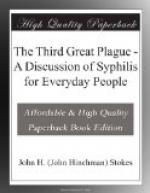+Variations on the Rule.+—It should never be forgotten that all these rules are subject to variation, and that where one woman may have a series of miscarriages so close together that she mistakes them for heavy, irregular menstrual flows, and never realizes she is pregnant, another may bear a living child the first time after her infection, or still another woman after one miscarriage may have a child so nearly normal that it may attain the age of twenty or older, before it is suspected that it has hereditary syphilis. Again a woman with syphilis may remain childless through all the years of her active infection, and finally, in her first pregnancy, give birth to a healthy child, even though she still has the disease in latent form herself. Still another may have a miscarriage or two and then bear one or two healthy children, only to have the last child, years after her infection, be stillborn and syphilitic. The series of abortions, followed by stillborn or syphilitic children, and finally by healthy ones, is only the general and by no means the invariable rule.
+Treatment of the Mother.+—For the mother, then, syphilis may mean all the disappointments of a thwarted and defeated maternity, and the horrors of bearing diseased and malformed children. She is herself subject to the risk of death from blood poisoning which may follow abortion. But here, as in all syphilis, early recognition and thorough treatment of the disease may totally transform the situation. In the old days of giving mercury by mouth and without salvarsan, there was little hope of doing anything for the children during the active infectious period in the mother. Now we are realizing that even while the child is in the womb the vigorous treatment of the mother may save the day for it, and bring it into the world with a fair chance for useful and efficient life. More especially is this true when the mother has been infected while carrying the child, or just before or as conception occurred. In these cases, salvarsan and mercury, carefully given, seem not only not harmful to mother and child, but may entirely prevent the child’s getting the disease. For this reason every maternity hospital or ward should be in a position to make good Wassermann blood tests, conduct expert examinations, and give thorough treatment to women who are found to have syphilis. There does not seem to be any good reason why a Wassermann test should not be made part of the examination which every intelligent mother expects a physician to make at the beginning of her pregnancy. Such a test would bring to light some otherwise undiscovered syphilis, and protect the lives of numbers of mothers and children whose health and happiness, not to say life, are now sacrificed to blind ignorance.




